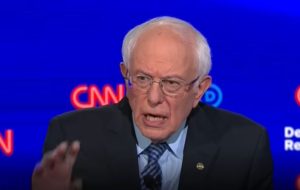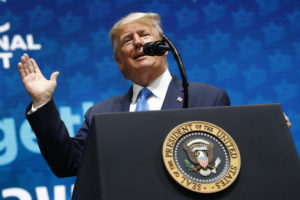A Crippled Supreme Court Awaits an Election in Which Hillary Clinton Is the Lesser Evil
The next president of the United States will have the power to reshape the nation’s ultimate judicial body—and redefine the meaning and application of the Constitution for a generation or more.
The next occupant of the Oval Office could name as many as four new justices to the U.S. Supreme Court. (Phil Roeder / CC BY-SA 2.0)
As the Supreme Court begins its new term on Oct. 3, an old adage comes to mind. It was first penned by the satirist Finley Peter Dunne in 1901. Purged of its original Irish brogue, the saying admonishes: “The Supreme Court follows the election returns.”
Never has Mr. Dunne’s observation seemed more on target than today. Since the death of Justice Antonin Scalia last February, the court has been evenly divided, 4-4, between its conservative and liberal members. The division has brought about a stasis in the court’s work, trimming the sheer number of new cases it has agreed to hear and causing it to avoid taking on the usual number of high-profile constitutional challenges.
To put it bluntly, the court is crippled, and it won’t be healed until the next president is elected. Exactly how it is repaired—in a manner that sets it on a hard right-wing or a moderately liberal path—depends on whether Donald John Trump or Hillary Rodham Clinton succeeds Barack Obama as commander in chief. Regrettably, third-party hopefuls Jill Stein and Gary Johnson have no realistic chances.
Although Trump and Clinton didn’t discuss the court during the first presidential debate, they hold sharply divergent visions of the institution’s future. For anyone to the left of the tea party, Clinton—with all of her family scandals, policy faults and personal flaws (many of which I have cataloged in this column)—is the lesser electoral evil when it comes to the court and constitutional law. It’s not even a close call.
I’ll explain why in a moment, but first, let’s preview the sparse roster of cases that have been added thus far to the court’s docket for the upcoming term.
The first thing you’ll notice is that the total number of pending cases is significantly down. Last term, even with Scalia’s passing, the court issued 69 decisions on the merits. The justices deadlocked 4-4 in four of those cases, including major lawsuits involving public employee unions (Friedrichs v. California Teachers Association) and President Obama’s deferred deportation programs (United States v. Texas). By contrast, during this term, the court has granted review in just 31 cases as of this writing.
The court undoubtedly will agree to accept additional appeals in the next month or two—it has to, if for no other reason, than to allow the justices to fill out their timecards and collect their paychecks. But the institution is a shadow of its former vigorous self.
As Dean Erwin Chemerinsky and professor Joan Biskupic—both of the University of California, Irvine School of Law—noted in a September academic podcast, the court is embarking on a new term without Scalia for the first time in 30 years. Chemerinsky and Biskupic asserted that Scalia’s demise has left the court in a “holding pattern” until the election, forcing it to look for “compromise” and “easy solutions.” Missing, they explained, are the legal blockbusters that marked past sessions on such issues as gun rights, campaign finance, abortion, Obamacare, affirmative action and same-sex marriage.
Still, there are some weighty matters on the present docket that deserve attention.
In a pair of lawsuits that have been consolidated for decision and oral argument—Bank of America Corp. v. City of Miami and Wells Fargo & Co. v. City of Miami—the court will examine the practice of “reverse redlining” by two of the country’s biggest banks.
The suits arose from the financial crisis of the last decade, when lenders enticed poor and minority customers to buy homes with subprime mortgages the buyers could not afford to repay. When massive numbers defaulted on their loans, cities such as Miami suffered drastic reductions in property tax revenue. The cases will establish whether municipalities (and not just individuals) have legal standing under the federal Fair Housing Act to bring discrimination claims for money damages against predatory lenders involved in malfeasance.
In Trinity Lutheran Church v. Pauley, the court will tackle a combined First Amendment establishment clause and 14th Amendment equal-protection question, deciding whether a religiously affiliated Missouri school is eligible to receive state grant funds, just as nonreligious schools are. In an unusual alliance, the state of Missouri and the American Civil Liberties Union (which has filed an amicus, or friend-of-the-court, brief) maintain that the establishment clause prohibits any use of taxpayer funds to support houses of worship.
Another pair of cases that are related but likely will be treated separately—McCrory v. Harris and Bethune-Hill v. Virginia State Board of Elections—will determine whether North Carolina and Virginia, respectively, engaged in “racial gerrymandering” when they redrew their voting districts after the last census. Under current law, gerrymandering is unconstitutional if the predominant factor in the configuration of legislative maps is race and the dilution of minority voting power.
Capital punishment also will be on the court’s agenda in two cases from the Lone Star State—Moore v. Texas and Buck v. Davis. In Moore, the court will debate the medical standards Texas uses to determine whether death-row inmates are intellectually disabled. The justices will decide whether those standards are so outdated they violate a 2002 precedent, Atkins v. Virginia, which held that the Eighth Amendment bars the execution of “mentally retarded” inmates.
In the other Texas case, the court will be asked to reverse the death sentence of Duane Buck, a black man who committed a double murder in 1995.
Texas is one of two states—Oregon is the other—that requires capital juries to determine whether defendants convicted of murder pose a risk of “future dangerousness” if they are given life sentences instead of death verdicts. At Buck’s trial, his defense counsel unwittingly elicited testimony from a psychologist who opined that, statistically speaking, black men are more apt to commit crimes of violence than men of other races. The jury returned a death sentence, which Buck has been appealing for years in federal court via successive habeas corpus petitions.
Although consideration of a defendant’s race in death-penalty jury deliberations is clearly unconstitutional, and while Buck’s lawyer undoubtedly rendered inadequate assistance of counsel in violation of the Sixth Amendment, the state argues that his current Supreme Court appeal should be dismissed because he failed to raise the issue of his lawyer’s competence at an earlier stage.
The problem for Buck is that the Anti-Terrorism and Effective Death Penalty Act of 1996, sponsored by former President Bill Clinton, makes it extremely difficult for state death-row inmates to obtain federal habeas corpus relief. The criteria and procedures set up by the act basically limit inmates to one federal petition, unless they obtain a “certificate of appealability” (COA) from a federal court. To get a COA, an inmate has to make a “substantial showing” that he was denied a constitutional right at his trial. Last year, the Fifth Circuit Court of Appeals ruled that Buck had failed the test.
Hillary Clinton, as first lady, gave her full-throated support to the 1996 act. To this day, she continues to support the death penalty for what she has said are “limited purposes,” such as terrorist attacks.Ordinarily, from a progressive perspective, such views might disqualify Clinton as the lesser of two evils regarding the issues that might come before the Supreme Court—and the sort of people she might elevate to the bench.
But this is no ordinary election.
Donald Trump’s views on capital punishment are far more draconian. He’s been an ardent and outspoken supporter of the ultimate penal sanction since he took out full-page ads in New York City newspapers in 1989, condemning the Central Park Five (local youths falsely convicted of a gruesome rape) and calling for the restoration of the death penalty in the state. More recently, he’s advocated for the execution of Edward Snowden, along with full restoration of the Patriot Act.
Clinton is by no means a Snowden fan, either. She wants him extradited and tried for espionage, although she has never suggested the death penalty. She has also called for an “intelligence surge” to combat terrorism at home and abroad.
But on a range of perennial constitutional questions likely to return to the court in years to come, Trump and Clinton stand distinctly apart. For example:
● Trump has restyled himself as “very pro-life.” Clinton is a staunch defender of abortion rights.
● Trump has courted the National Rifle Association as a champion of the Second Amendment. Clinton favors stricter gun regulation.
● Trump initially was critical of the corrupting influence of money in politics and the role of super PACs in funding elections. He has since hired David Bossie, president of the Citizens United advocacy organization, to work as his deputy campaign manager, and has embraced his own set of super PACs. Clinton, despite her unflagging pursuit of huge campaign contributions, has nonetheless pledged to support a constitutional amendment to overturn the Citizens United decision that prohibited the government from restricting political expenditures by nonprofit corporations. She also has vowed to place justices on the Supreme Court who believe the ruling should be reversed.
In addition, Trump has come under fire by the ACLU and other civil liberties groups for his positions on immigration and deportation. These groups oppose Trump’s ideas to build a border wall, conduct Muslim surveillance, extend stop-and-frisk law-enforcement operations, legalize the torture of terror suspects and “open up” the nation’s libel laws to let the super-rich more easily sue news outlets that publish allegedly defamatory material.
Presidents, of course, can do little on their own to change the course of constitutional law. Instead, they impact the Constitution largely through their power to nominate federal judges.
Of all the factors presidents consider in the selection process, none is more central than political and ideological compatibility. Trump, to his credit, has been consistent and transparent about his plans to appoint Supreme Court justices in the political mold of Scalia.
True to that promise, he has to date released two lists of potential high-court nominees, totaling 21 individuals in all, the first batch released in May and the second in September. Both lists are weighted heavily with white males and activists from the conservative Federalist Society based in Washington, D.C.
The lists feature eight federal appellate judges, two district-court judges, nine state judges, one panelist from the U.S. Court of Appeals for the Armed Services and Sen. Mike Lee, R-Utah. Trump’s selections from state courts include Lee’s brother Thomas, who sits on the Utah Supreme Court, and Texas’ Dan Willet, who, like Mike Lee, was an enthusiastic backer of Ted Cruz during the GOP primaries. Willet is known as the “Tweeting Judge” due to his fondness for taking to social media to express his musings about the world.
Among those considered most likely to become Trump’s first Supreme Court nominee are Diane Sykes of the U.S. Court of Appeals Seventh Circuit and William Pryor of the 11th Circuit. As I observed in a Truthdig column in May, both are strong supporters of voter ID suppression techniques, Hobby-Lobby style religious freedom and the concept of “corporate personhood.” They are also fervently anti-abortion and opposed to gay marriage.
I profiled Sykes in a November 2013 column entitled, “Meet the Worst Judge in America.” On balance, however, Pryor may be even more of a threat to constitutional norms. Nominated to the federal bench by former President George W. Bush, he was confirmed by the Senate on a narrow 53-45 vote after a prolonged filibuster. In his former post as attorney general of Alabama, he described Roe v. Wade as “the worst abomination in the history of constitutional law,” and Miranda v. Arizona as one of the “worst examples of judicial activism.”
Clinton, for her part, has not released any names publicly. However, news reports suggest she has assembled a short list of 11 possible Supreme Court appointees. They include Merrick Garland (President Obama’s pending nominee, who is currently the chief judge of the D.C. Circuit Court of Appeals), along with eight other federal and state judges and senators Amy Klobuchar, D-Minn., and Cory Booker, D-N.J.
Except for Klobuchar and Booker—and I’ll throw in Garland, who is now widely known for being denied a Senate confirmation hearing—none of Clinton’s picks are household names. Nor are any likely to make students of constitutional law forget progressive stalwarts like the late justices Thurgood Marshall, William Brennan or Earl Warren. Still, elevation of any one of them as Scalia’s successor would move the court in a more moderate trajectory.
But replacing Scalia is just the beginning. Unless Father Time goes on permanent leave or the laws of nature suddenly are suspended, the next occupant of the White House will get to name not just one but as many as four new justices. Justice Ruth Bader Ginsberg, the reigning queen of the court’s liberal wing, is 83 years old. Justice Anthony Kennedy is 80, and Justice Stephen Breyer is 78.
Since 1970, the average tenure of Supreme Court justices has exceeded 26 years. This means the next president will have the power to reshape the nation’s ultimate judicial body, and with it, the power to redefine the meaning and application of the Constitution, not just for the next four or eight years, but for a generation or more.
The prospect of turning over that power to a racist and xenophobic former host of a reality TV show may not be enough to suppress the urge to cough up your lunch at the prospect of voting for Clinton as the lesser evil. But, at the very least, it should get you to rethink the greater dangers of seeing Donald Trump take his reality show to the Oval Office.
Independent journalism is under threat and overshadowed by heavily funded mainstream media.
You can help level the playing field. Become a member.
Your tax-deductible contribution keeps us digging beneath the headlines to give you thought-provoking, investigative reporting and analysis that unearths what's really happening- without compromise.
Give today to support our courageous, independent journalists.






You need to be a supporter to comment.
There are currently no responses to this article.
Be the first to respond.